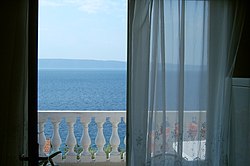
Ninon is a lightweight, sheer fabric made with plain or leno weaving. It is a suitable material for curtains, evening wear and lingerie. [1] [2] [3] Ninon is made with variety of filament yarns such as polyester, [4] silk, rayon or nylon. [5] [6] [7] [8]